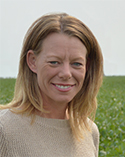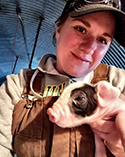News
March 31, 2020
#farmingforyou
Topic: Issues
 John Jacobson, eastern North Dakota:
John Jacobson, eastern North Dakota:
It has been hectic around here. Calving is just beginning, the river is already close to the highest I've ever seen it here and I'm trying to help kids with schoolwork because Stacey has been putting in more than normal hours at the clinic in preparation for a worst-case scenario.
The COVID19 deal has created some unique challenges in preparation for the 2020 crop year. Markets have all been heading the wrong direction which has made it extremely difficult to make a crop plan for 2020. We have a general rotation that we loosely follow but some of the planting decisions are based on which crops we think may be profitable or not. Right now, nearly everything is at or below the cost of production.
The specialty crops we grow which do appear to be profitable this year, we cannot locate any seed for. The other difficulty we have in my area is that last fall was extremely wet. That means fields will be wetter than normal this spring. Couple that with all the work we still need to do that we didn't get done last fall means we are going to struggle to get crops in the ground in a timely manner.
Probably the biggest frustration for me regarding COVID19 is marketing our cattle. Our program is set up to sell our calves in March. We begin calving around the first of April. Last year's calves need to be moved prior to the new crop coming so we can clean and bed pens to be ready for the new ones.
Boxed beef has been at near record prices while the price paid to cattleman at the sale barn was down roughly 30%. The easy answer is to keep the cattle longer, but like I said, we need the pen space for calving. I've talked to many cattle producers that were in the same boat of not having either the room or the feed (feed production was down due to a wet year last year) to hang on to them longer and ride this thing out.
 Sarah Lovas, eastern North Dakota:
Sarah Lovas, eastern North Dakota:
The way COVID19 has affected agriculture is interesting indeed.
As a farmer, I take the job of providing safe and affordable food very seriously. I believe the food chain is secure and the USA will not go hungry. The U.S. government has also deemed agriculture to be a critical industry so we will be able to conduct business even if it includes some challenges. If you have noticed grocery stores without bread and milk, don’t worry. We will get that caught back up. Isn’t it great to live in a country with great food security?!
Farmers try to sell the crop when there is a marketing opportunity to sell the crop at a profit. For example, if we see an acceptable price to sell at harvest time, we will forward contract that price for delivery at harvest. For the 2020 crop, I have already sold bushels of corn, wheat, and soybeans for delivery in September, November, and December, respectively. These bushels were sold in December of 2019. The number of bushels sold at a profit or the perceived market opportunity can steer planting decisions as to what crop and how many acres of that crop gets planted.
Due to depressed prices this year, deciding what crop should be planted has been challenging. We have been faced with more than just COVID19. There was also a trade dispute over oil between Saudi Arabia and Russia, and we are waiting for the Phase 1 China Trade War Agreement to become active. COVID19 makes marketing challenging because it seems like most marketing analysts don’t know how to interpret the current marketing situation. As a farmer, the market unpredictability and the experts’ lack of understanding makes it difficult for us to understand the markets and how to make a marketing plan around all of these issues.
Right now, in a normal year, we should be planning planting season. This means we decide what crop to plant, where it should be planted, and plan the seed, fertilizers, and other inputs for that crop. We will follow a crop rotation, but North Dakota has a lot of crop diversity and so we have many crops that we can choose to raise based on what the market tells us it wants. Right now, most marketing prices for crops are below cost of production and so it is difficult to plan what crop should get planted.
Further, 2019 provided us with weather challenges as well and these challenges are carrying over into 2020. In my area last year, we had a lot of rain which created extremely wet conditions so that the crop was impossible to harvest. There are still a number of un-harvested acres from 2019 that won’t be harvested and currently as I write this on 3/31/20 there are farmers who are still trying to harvest 2019 corn today. The snow is melting now, and the ground is un-thawing which means we are also being faced with muddy and flooding conditions in the area. It is realistic to predict that some of 2019 corn won’t be harvested until after the planting season 2020 is completed. At that point in time, it will probably be too late to plant those fields to other crops and those field will lay idle for the year.
There have been logistical changes due to COVID19. We can’t meet face to face with bankers, insurance agents, the USDA FSA representatives, and suppliers. This creates challenges during a season when we are doing the majority of planning for the cropping year. However, we have been able to figure out ways around it through e-meetings, phone calls and other means.
When it comes to day to day activities, we are still getting the job done. There isn’t a lot of grain being delivered to local elevators, because the market price isn’t above cost of production right now. However, if someone wanted to haul in grain, you don’t really have to see or talk to anyone at the elevator, so taking grain to market isn’t a big challenge. There are even phone apps for receiving the grain tickets electronically. Keep in mind there are a couple of very old-fashioned country elevators that may have to change how they received grain and/or accept it after COVID19 crisis is over. When it comes to planting, we will have most of the crop inputs delivered to the farm, and the drivers usually unload themselves because we are out in the field, so we usually don’t see each other. When coordinating agronomic input deliveries and custom application of fertilizer, I usually email the application maps and text or call to coordinate all the logistics anyway. I’m usually out in the field and don’t have time to drive into an office for a face to face meeting to coordinate this. Also, there is no better place to socially distance yourself than in the cab of a tractor in the middle of a 160-acre field (think about 1 acre being about the size of a football field), and we do this every year for more than 14 days at a time!
In a way, COVID19 feels like just another challenge that agriculture is facing today. However, I think it’s important for the United States to know that their food chain is secure. We take our job of producing food very seriously. We WILL plant the crop. We WILL harvest the crop. There will be safe, affordable food available for consumers in the grocery stores and restaurants, when they open again.
 Heather Lang, western North Dakota:
Heather Lang, western North Dakota:
In a way farmers and ranchers have been practicing social distancing their entire lives. We enjoy God's beauty all around us in the wide-open spaces. We typically interact with our animals more than humans on a daily basis. Being around the house is comforting to us even in the midst of all the pressure we have to provide a safe, healthy food supply for the world.
Our trips to town are very limited and planned, so my typically grocery shopping trip looks like most do now during these times. I have a heaping cart full of food because I try to go only once a month. My cart is full of all the essentials (minus meat since we have the luxury of raising our own).
Around our farm it is "business as usual" for the most part. The everyday activities are still being done. We are preparing for spring planting, preparing to get the cows out into the pastures, and our calving season is about to get started any day. Lots of new life is being born here on the farm with lambing and farrowing season still in full swing.
There are some things that have been added to our plate. Since we have three elementary aged kids at home, I have now added being a homeschool teacher to the tower of hats I wear every day.
The wet conditions we had last year still leave us facing challenges such as trying to get all the hay off the fields and hauled home, plus we are trying to finish corn and flax harvest. Farmers and ranchers are constantly adapting to new challenges, turmoil and struggles. We do sell live animals straight to the consumers who then take it to be processed getting all their custom cuts that they would like. Since this COVID19 outbreak we have had a lot more inquiries wanting to support our local farm. So, for the most part it is business as usual on our farm.
Although the pain being felt by so many during this pandemic is not okay, I am still trying to be as positive as possible:
1. I have the kids home all day, which is an added bonus because we now have more hands to help with things that need to get done and they are great workers
2. Food waste will hopefully decrease as people realize they need to be more careful about how much they purchase or make at a time.
3. Materialistic things don't matter. Family does.
4. Faith over fear.
